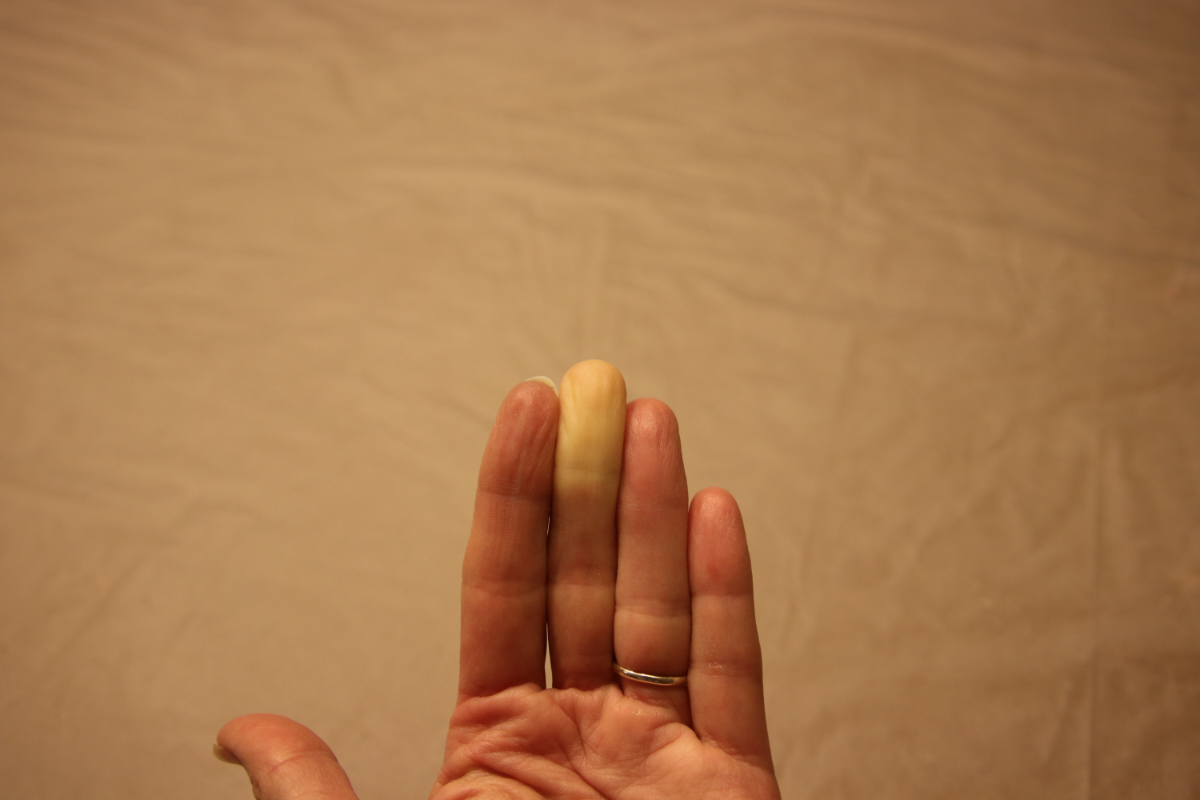Acrocyanosis is characterized by diffuse and permanent cyanosis of the hands, fingers, feet and toes. This condition is linked to a vascular spasm . The cyanotic areas are most of the time cold and moist, there is also a diffuse excessive sweating . This disorder is predominant in women. Above all, we will look for:
- Often associated signs of neuro-vegetative imbalance (palpitations, migraines, urticaria).
- Emotional disturbances, often present.
- A more or less discreet anorexia .
- Hormonal disorders.
Homeopathic therapy will revolve around the atony of capillaries and veins, neuro-vegetative and emotional signs, as well as the field.
Raynaud’s syndrome , for its part, consists of a vasomotor disorder of the extremities which manifests itself by vasoconstrictive attacks most often limited to a few fingers, triggered by cold and psychic stress . The attacks can approach and be complicated by trophic disturbances. This syndrome is more common in women. We will try to find a cause: chronic arterial disease, occupational intoxication (lead, arsenic), repeated trauma by vibrating tools, taking certain drugs, haematological ailments, bilateral cervico-thoracic parade syndrome, frostbite, primary pulmonary hypertension, carcinoma. However, it will most often be Raynaud’s syndrome Idiopathic for which the role will be specified cold, the stress and the instability autonomic , and the role of the different phases of the menstrual cycle .
Clinically, a sequence of pallor, cyanosis and redness is observed in particular during the course of the attacks.
These two pathologies are in fact linked to arterial spasms. For these two conditions, acrocyanosis and idiopathic Raynaud’s syndrome, homeopathic medicines will be the same ; it will be necessary to choose them according to the symptoms specific to the patient. In this article we will describe symptom drugs and field drugs.
Drugs for symptoms of acrocyanosis and Raynaud’s syndrome
Agaricus :
Experimentally, this substance causes itching erythema in the skin with the impression of being pricked by a multitude of ice needles , as if the skin had been frozen, and at the nervous level, tremors and tetaniform convulsions. This drug is indicated in acrocyanosis and acrodynia of the hands and feet, sometimes with stinging and burning pains. There may be some itching of the affected areas.
Dosage : Take in 7, 9 or 15CH, 5 granules 1 to 2 times a day.
Arnica :
Drug with capillary tropism, it is almost systematic indication in this pathology.
Dosage : Take in 7, 9 or 15CH, 5 granules 1 to 2 times a day.
Carbo vegetabilis :
Cyanosis drug, it is indicated both in Raynaud’s syndrome and in acrocyanosis if there is an objective cold of the skin , a network of capillaries, cyanosis of the extremities and a feeling of internal burning .
Dosage : Take in 7, 9, or 15CH, 5 granules 1 to 2 times a day.
Hamamelis virginiana :
This substance has an elective action on the venous system, with a tendency to passive congestion.
Dosage : Take 20 drops in 6DH, 2 times a day.
Secale cornutum :
This drug corresponds to Raynaud’s syndrome with sensations of tingling, paresthesia, burning of the extremities with objective cooling. Burning pains are improved by cold . There may be the appearance of trophic disorders .
Dosage : Take in 5CH, 2 times a day.
In the event of trophic disorders, the appropriate local treatment will be combined.
Field drugs for acrocyanosis and Raynaud’s syndrome
The diagnosis of these drugs will be made more on the general or concomitant signs than on the circulatory signs, except for Pulsatilla which presents a specific circulatory aspect. We will only give the circulatory characteristics of the drugs which essentially correspond to the psoric mode of reaction.
Pulsatilla :
The patient presented with erythrocyanosis of the extremities aggravated by heat and rest, improved by walking in the open air . However, the cold worsens these patients whose extremities become icy and may present with frostbite.
Dosage : Take in 9 or 15CH, once a day to once a week.
Natrum muriaticum :
Paresthesias, cold extremities are aggravated by emotions . Natrum muriaticum finds its indication in Raynaud’s syndrome. There may be a context of relative anorexia .
Dosage : Take in 9 or 15CH, once a day to once a week.
Phosphorus :
There is some congestion in the extremities with a tendency to sweating at the slightest effort.
Dosage : Take in 9 or 15CH, once a day to once a week.
Tuberculinum :
The pathogenesis of this drug is fatigability, sweating at the slightest effort, peripheral venous stasis and dystonia described as characteristics of these syndromes .







